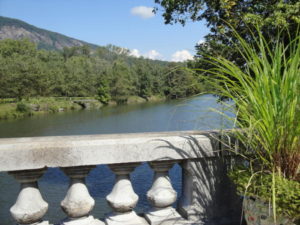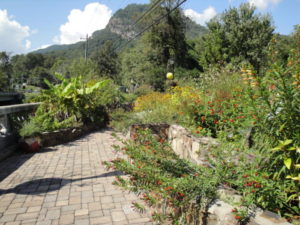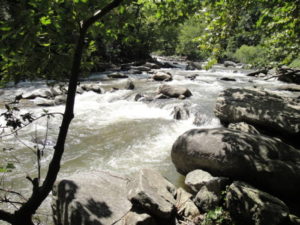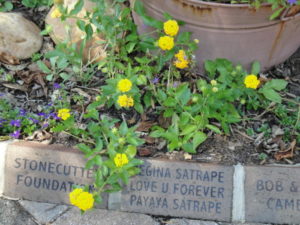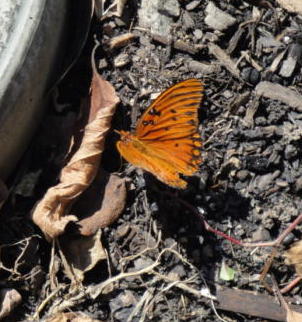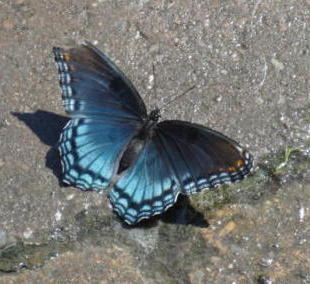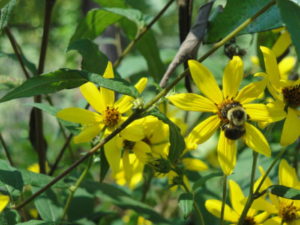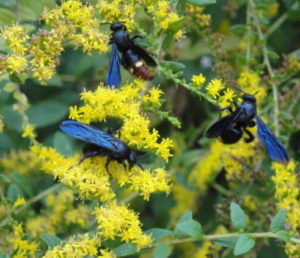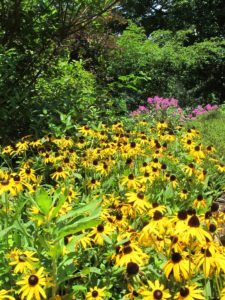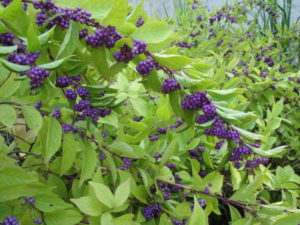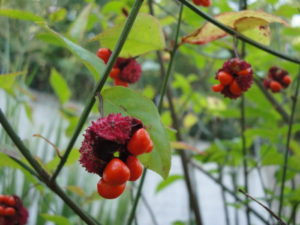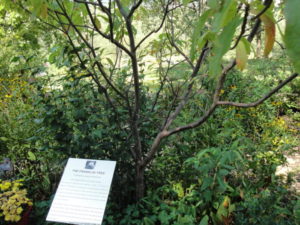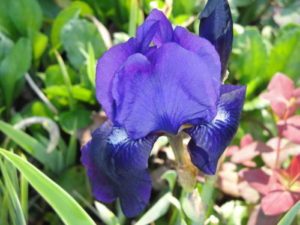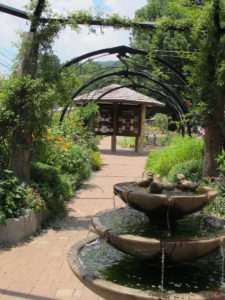A Trip To the Lake Lure Flowering Bridge
Yesterday, US 64/US 74-Alt/NC 9 delivered me to the Lake Lure Flowering Bridge. The weather forecast predicted a hot Saturday here in Charlotte. So I decided to take another trip to the mountains of western North Carolina. There’s rarely a plan or an itinerary of any sort, but I always end up somewhere.
I have been there before, once a couple of years ago to walk the length of the bridge, and many times as a drive-by viewer on my way to…somewhere. If I had stayed home, I would have felt compelled to plant the potted vegetables that were quietly pleading, “Plant us…Plant us!”
A Little History
This “Gateway to Somewhere Beautiful”, it’s called, opened in 2013, after a new bridge had been built 2 years earlier, right next to it. The original 1925 bridge and now this pedestrian walkway span the Rocky Broad River, which feeds Lake Lure, an easy stroll along the Town Center Walkway. (Parts of the movie “Dirty Dancing” and other movies were filmed here.) Stunning stone backdrops surround the lake, where you can enjoy water sports, dine, or simply sit back and take it all in.
The Visitor Center, between the lake and the garden, houses a small museum with artifacts and informative historical displays. You can trace the history of the Hickory Nut Gorge from the time of the Cherokee and Catawba Indians. Read about the area’s involvement in the Civil War and the Gold Rush, to today’s economy, centered around agriculture, industry, and tourism.
The garden has been designated a Monarch Way Station by Monarch Watch. And the National Wildlife Federation includes it in its Certified Wildlife Habitat program. It is known as “Historic Bridge Seven” in the Register of Historic Places.
A short drive down the road is Chimney Rock State Park (“The Last of the Mohicans”) and the always bustling Chimney Rock Village. Here you can enjoy shopping and outdoor dining while being mesmerized by the sound of rushing water cascading down the rocky incline. Did I mention how scenic this area is? Spectacular!
Back to the Garden
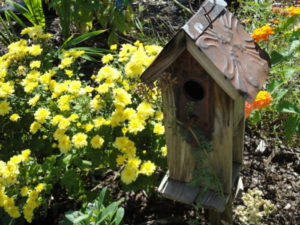 A paved pathway takes visitors through a succession of gardens. There’s an herb garden, a fragrance garden, and one that highlights tropicals. And a miniature train garden, succulents, and roses. Annuals are planted here and there, providing vibrant color and nectar for the bees, butterflies, and other beneficial insects.
A paved pathway takes visitors through a succession of gardens. There’s an herb garden, a fragrance garden, and one that highlights tropicals. And a miniature train garden, succulents, and roses. Annuals are planted here and there, providing vibrant color and nectar for the bees, butterflies, and other beneficial insects.
Perennials and woody plants are the backbone of this garden, and each section has a plant list to help identify individual specimens. This garden is open all year, inviting opportunities for new experiences every time I visit.
Expanding gardens spill out over the ends of the bridge span, offering more potential garden space. The parking lot is at one end, near the huge maple tree (2019—now a stump!). Planted near the other end of the garden is a Franklin tree, which no longer exists in the wild. You can stay on the level curvy paved path or explore several side pathways.
There is no charge to visit, but do leave a donation in the box near the lake end of the walk. Contribute $200 (today=?) and have an engraved brick placed along the path. This garden is planted and maintained entirely by a group of hard-working volunteers.
Everywhere you go, you will see whimsical additions to the landscape. There are bird baths with good-luck coins (cameras are watching, the signs say), and repurposed painted doors. That’s a nice touch along a path as the garden transitions into another style or simply to add a splash of color.
You’ll see metal sculptures from inconspicuous to the can’t-miss Opuntia, houses for birds and bees, and an old chair with the seat replaced with a sack of soil and succulents.
Wildlife
- Gulf fritillary butterfly.
- Chrysalis on elephant ear.
- Red-spotted purple butterfly.
The bright orange butterfly is a Gulf Fritillary. Males are bright orange, and females are slightly browner. The caterpillars feed on passion flowers (Passiflora), and adults take nectar from butterfly bush (Buddleia), lantana, zinnia, and other flowers.
Where water drained from one of the raised beds, a butterfly called the Red-Spotted Purple paused for a mineral drink. The larvae of this butterfly feed on several species of trees, including amelanchier, aspen, birch, poplar, and wild cherry. Adults find sustenance from dripping tree sap, rotten fruit, carrion…and dung. Sometimes they sip nectar from spirea, viburnum, and privet flowers. Birds avoid the red-spotted purple because it mimics the poisonous pipevine swallowtail butterfly. But I wonder if that’s the only reason.
This chrysalis (photo, above) clings to the back of an elephant ear leaf. Tropical Colocasia plants add dramatic presence to a garden, with huge green or purplish-black arrowhead leaves.
Another butterfly skipping around the lantana and the basil flowers was the Clouded Sulfur butterfly. Small lizards (green anoles) scurried off when disturbed.
A cultivar of the perennial native sunflower (Helianthus) was a favorite of the bees. This stately plant grows to 7′ tall and offers bright color in sun to partial shade when little else flowers there at this time of year.
A water hose thoughtfully left on the edge of the sidewalk filled a bowl for thirsty dogs. It was a hot day! Heading back to the parking lot, the metal archway misted cool water on visitors who chose to take this route. That felt great.
So, What’s Blooming Now?
Perennials
Camera in hand, I clicked away as others smiled hello or asked “What’s that?” There were visitors from New York, and several from other countries. A lovely woman from Hickory commented on the turquoise-winged wasps all over the goldenrods (Solidago), and was curious to know the name of another yellow flower. It was listed on the nearby clipboard as Rudbeckia fulgida, a small-leaved black-eyed Susan. It’s native to the eastern U.S.
A popular seller at the Maryland markets where I sold plants was Rudbeckia fulgida var. fulgida, a better choice, in my opinion, than the ubiquitous ‘Goldsturm’. I’m not sure if the specimens on the bridge were R. fulgida, as indicated on the plant list, or R. fulgida var. fulgida. The latter black-eyed Susan, a slightly glossy-leaved variety of the species, starts blooming a week or two later than ‘Goldsturm’, but it continues non-stop until frost.
And it is not susceptible to that unsightly black mildew that often covers leaves of ‘Goldsturm’. Sure, the flowers are smaller, but, to me, it is the superior variety.
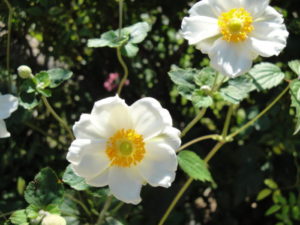
Anemone ‘Honorine Jobert’.
Reblooming bearded irises (“Update”, below) were budding up for an encore presentation, and chrysanthemums filled in the gaps. Tall, white Japanese Anemone ‘Honorine Jobert’ lit up the partly shaded recesses of the metal archway.
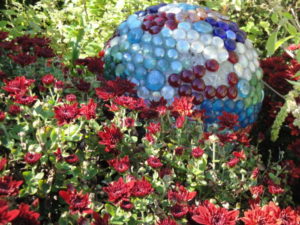
Burgundy chrysanthemum echoes similar color in glass bead sculpture.
More Perennials
New England asters, Gaura, pink turtlehead (Chelone obliqua), garden phlox (Phlox paniculata), and Sedum ‘Autumn Joy’ were finishing up their blooms. Ripening seedheads of coneflowers (Echinacea) and black-eyed Susans attract hungry birds, especially the finches. Now there’s a lesson for visitors to the Lake Lure Flowering Bridge—keep the seedpods on the plants for the birds!
Heuchera, also called alumroot or coral bells, is bulking up foliage for what I’m sure will be an impressive display next year. Cooler temperatures bring out a vibrancy in the foliage that rivals fall tree color. Hummingbirds visit the airy flowers for their sweet nectar.
Also growing in part shade was toad lily (Tricyrtus), with orchid-like purple spotted flowers. It won’t grab your attention as other brightly colored flowers will, but, viewed up close, it has its charms. The fact that it blooms at the end of the growing season and in mostly shady conditions merits placement along a woodland path.
Annuals

Ruellia, sometimes called Mexican petunia.
There’s great botanical diversity on the Lake Lure Flowering Bridge. The brochure states there are over 700 species of plants in this garden!
A few heat-loving annuals are blooming overtime, such as lantana, scaevola (fanflower), ruellia, cuphea, and zinnia, attracting butterflies and bees. Coleus varieties, partly shaded by the maple tree, will stay in leaf until cold weather or frost claims them.
While perennial gardening offers many benefits, the annuals deliver an abundance of color and the opportunity to grow something different every year.

Violas in our front yard flower through the winter.
In our front garden, near the sidewalk, I planted biennial violas a few weeks ago. Smaller cousins of the pansy, violas bloom all winter and spring in this USDA zone 7b location. They will succumb to late spring’s high temperatures.
The deer are fond of violas, so I spray the plants with a deer repellent every 3 or 4 weeks. I wonder if these plants will “bridge the gap” in this garden between fall and spring.
Shrubs
Many of the plants on the Lake Lure Flowering Bridge have noteworthy features in the fall. When landscaping your property, look for not only flowers, but also ornamental bark, attractive twigginess or structure, fragrance, fall color, fruits, and benefits to wildlife.
Beautyberry
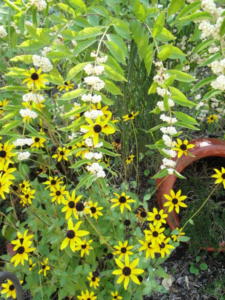
White Beautyberry, Callicarpa americana, overhanging Rudbeckia fulgida.
Beautyberry (Callicarpa americana), with branches gracefully bending under the weight of their fruits, is an easy shrub to grow. The birds feed on the ripe berries, distributing their seeds. Robins, mockingbirds, and thrashers will eat the berries when their favorite foods are no longer available.
There are both purple- and white-berried Callicarpa americana shrubs on the bridge. This beautyberry is a multi-stemmed shrub growing 4′ to 6′ tall. It’s native to the southeastern U.S., from Texas to Virginia, in USDA zones 6 to 10. Cultivars of Callicarpa dichotoma and other Asian species range from 3′ to 10′ tall.
I used to cut back the purple beautyberry (C. dichotoma) in our Maryland garden to only 6″ or 12″. Because flowers, and therefore berries, form on new growth, this approach keeps it more manageable in the landscape. In fact, delaying the pruning until mid spring (instead of late winter to early spring) will cause it to leaf out a bit later, keeping the plant even shorter and less “wild” looking.
Beautyberry is undemanding in a casual mixed border. This plant vigorously self-seeds, although birds consume many of the fruits.
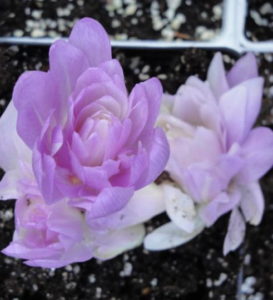
Colchicum autumnale ‘Waterlily’.
Planted near purple beautyberry in the Maryland garden, a fall-blooming bulb called Colchicum autumnale ‘Waterlily’ perfectly echoed the berries of the shrub. It is poisonous, so use with caution.
Mosquito Repellent
Fresh leaves of American beautyberry, Callicarpa americana, contain a substance that is said to repel mosquitoes and other biting insects.
I haven’t tried the beautyberry, but catnip (Nepeta cataria) always did an excellent job keeping mosquitoes away from me. Simply crush several leaves and rub it on your skin, adding a few drops of water to help distribute the natural repellent.
Strawberry Bush
Another shrub sporting curious-looking fruits is “hearts-a-bustin”, or strawberry bush. Euonymus americanus, native to the eastern U.S. (zones 6 to 9), is a suckering shrub, growing eventually to about 6′ by 6′. Inconspicuous flowers develop dark orange-red fruits in autumn, providing food for birds, but they’re toxic to us.
The untamed nature of this shrub is well suited to a wild native garden or on wooded slopes. Deer feed on the foliage and twigs.
This plant is susceptible to crown gall and, like other Euonymus species, to euonymus scale. But it does have interesting characteristics if you’re looking for a native plant to add to a woodland garden. Strawberry bush tolerates clay or sandy soil, and growing near black walnut trees.
The Franklin Tree
A Franklin tree (Franklinia alatamaha) grows near the lake end of the path. This medium sized tree is related to Camellia and Stewartia, in the family Theaceae. It has late season white flowers, vibrant red fall color, and ornamental striated bark. It needs well-drained, acidic soil, and dislikes compacted clay and wet conditions. Don’t plant it where cotton has been grown.
Franklinia has the reputation for being difficult to grow, but if you live within zones 5 to 8 and welcome a challenge…
Pennsylvania botanists John Bartram (1699-1777) and his son, William (1739-1823), “discovered” this plant in 1765. They collected specimens, saving the species from extinction, and named it in honor of their friend, Benjamin Franklin. All existing Franklin trees originated from specimens collected over 200 years ago, near the Alatamaha River in Georgia. Unfortunately, it disappeared from the wild at about that time.
Styrax Japonica

Japanese snowbell, Styrax japonica.
Another tree, one of my favorites, is the smooth-barked Japanese snowbell (Styrax japonica). This is a finely branched medium sized tree with fragrant dangling delicate white flowers that appear after the spring rush is over. Some of the seedpods can be seen splitting open (photo taken Nov. 3), revealing brown seeds inside.
The species has a lovely broad umbrella-shaped canopy, but newer cultivars tend to be more upright. It grows in zones 5 to 8. A pink-flowering cultivar is available.
Time To Go
On the road again, Route 64 climbs to a cool 2500′ elevation as it continues winding through small towns and apple fields toward Hendersonville, where I sometimes have a hefty tuna sandwich on marbled rye before heading home.
I’d like to see the garden’s winter light display, so I might return to see that. But the fall color in the mountains of western North Carolina will probably draw me back in a month or two. Most likely, the trip will include a stop at the Lake Lure Flowering Bridge.
***Update: November 3, 2018***
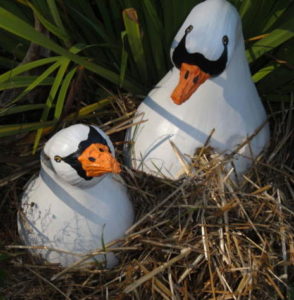
A pair of painted gourds.
On a quest for pictures of fall foliage in the foothills and lower elevation mountains of western North Carolina, I was reminded instead of the consequences of recent storms: broken limbs, toppled trees, and some rock slides…but no photo ops of fiery maples or golden hickories. The power of nature!
Today’s trip to the Lake Lure Flowering Bridge presented a few new subjects…
The rich purple reblooming irises didn’t disappoint. Several plants were in full flower, and some had more buds yet to unfurl. Blue fall-blooming asters welcomed busy honey bees, and purple coneflowers (Echinacea purpurea) still had some flowers. Clusters of yellow quilled petals crowned a robust Rudbeckia subtomentosa ‘Henry Eilers’.
- Fall-blooming aster.
- Late blooms of Rudbeckia s. ‘Henry Eilers’.
Throughout the garden, seasonal decorations nestled in among the plants and structures. Pumpkins of various shapes and colors, painted squashes, sequined straw-stuffed figures… Soon these undoubtedly will give way to wintry themes and holiday lights.
A local company called Mark of Excellence, Inc., had just completed building this new information kiosk (photo, below). Mark, like all other contributors to this garden, volunteered his services for the enjoyment of all visitors.
Even though it’s November, you can see that the growing season is hardly at an end! Visiting public gardens, parks, farmers’ markets, and garden centers during off-peak times of the year will tempt you with some of these season-extenders.
It doesn’t take much to get me outdoors, but give me some plants to fuss over, admire, or photograph…and, well…dinner will be a little late.
